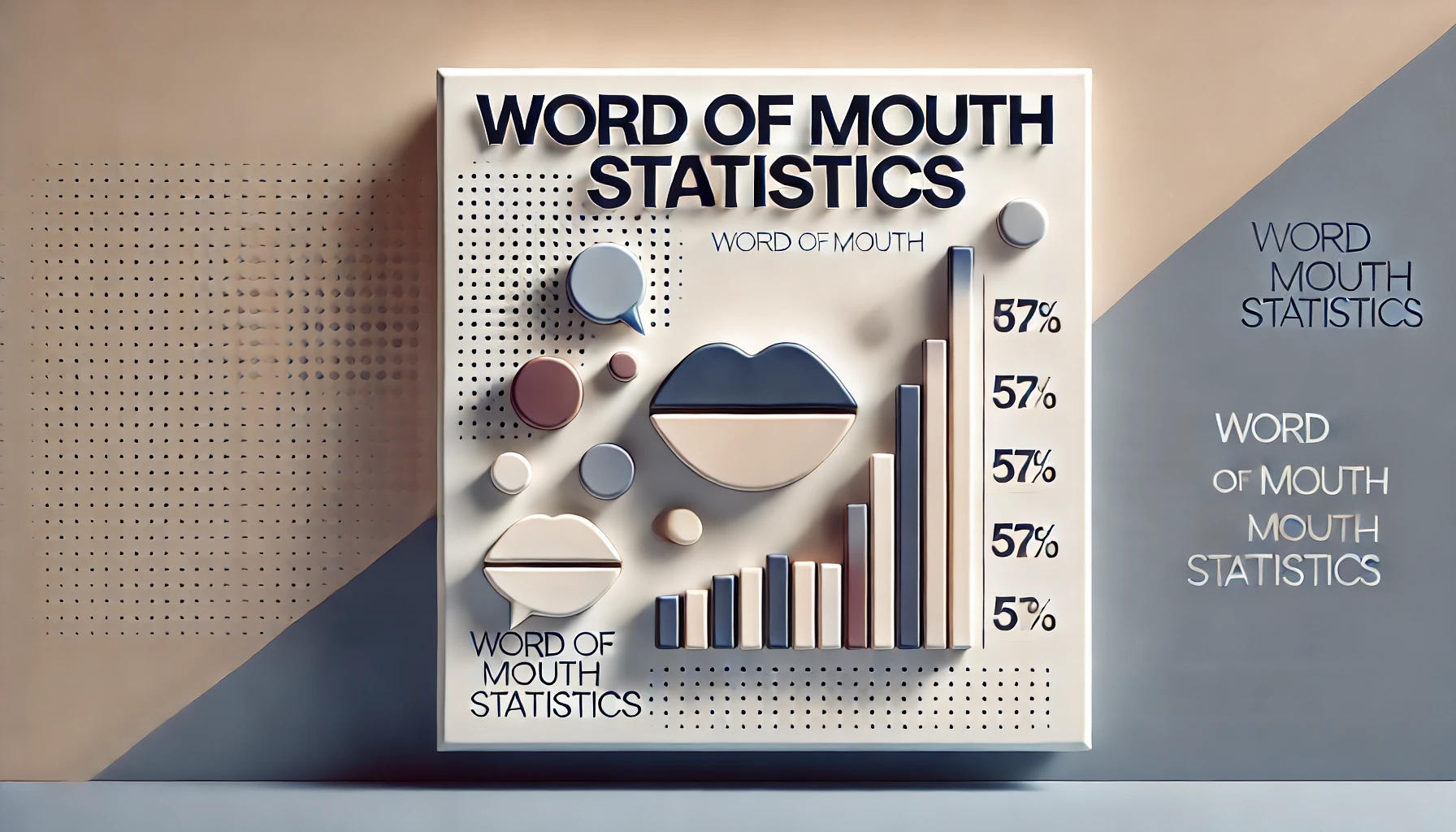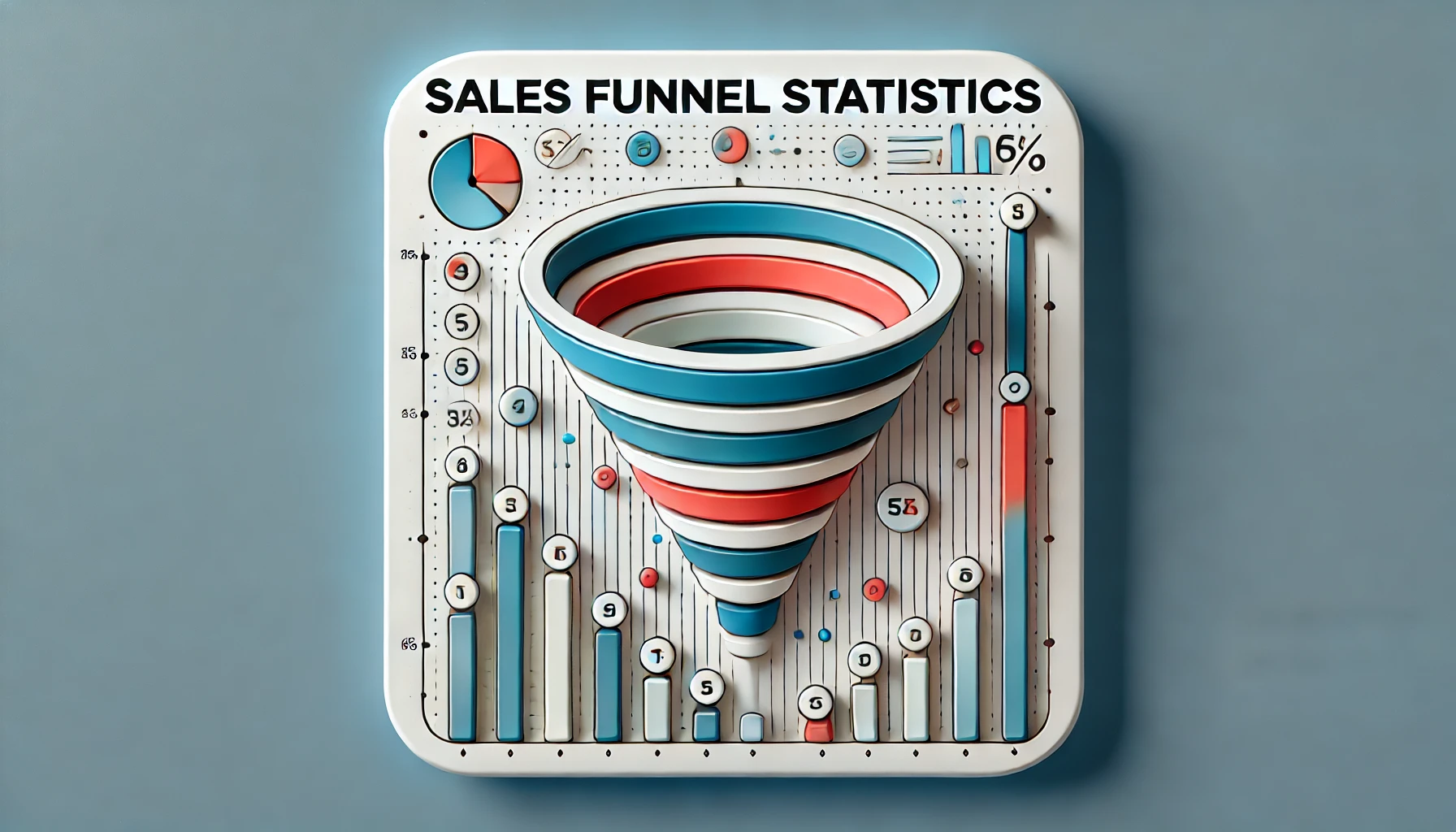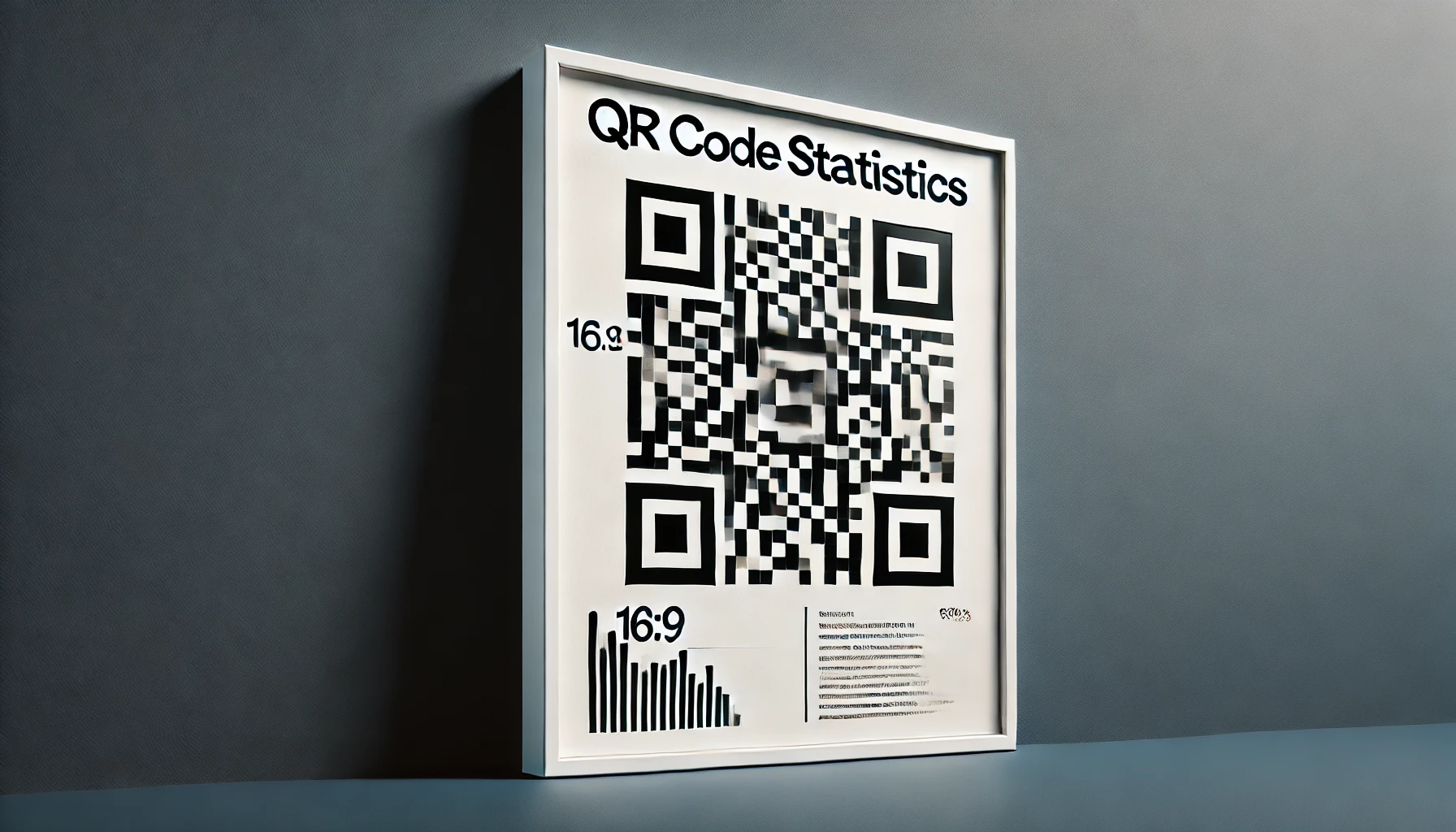Print Marketing Statistics By Types, Regions, Conversion Rate, Sales, Demographics And Future
Updated · Oct 01, 2024
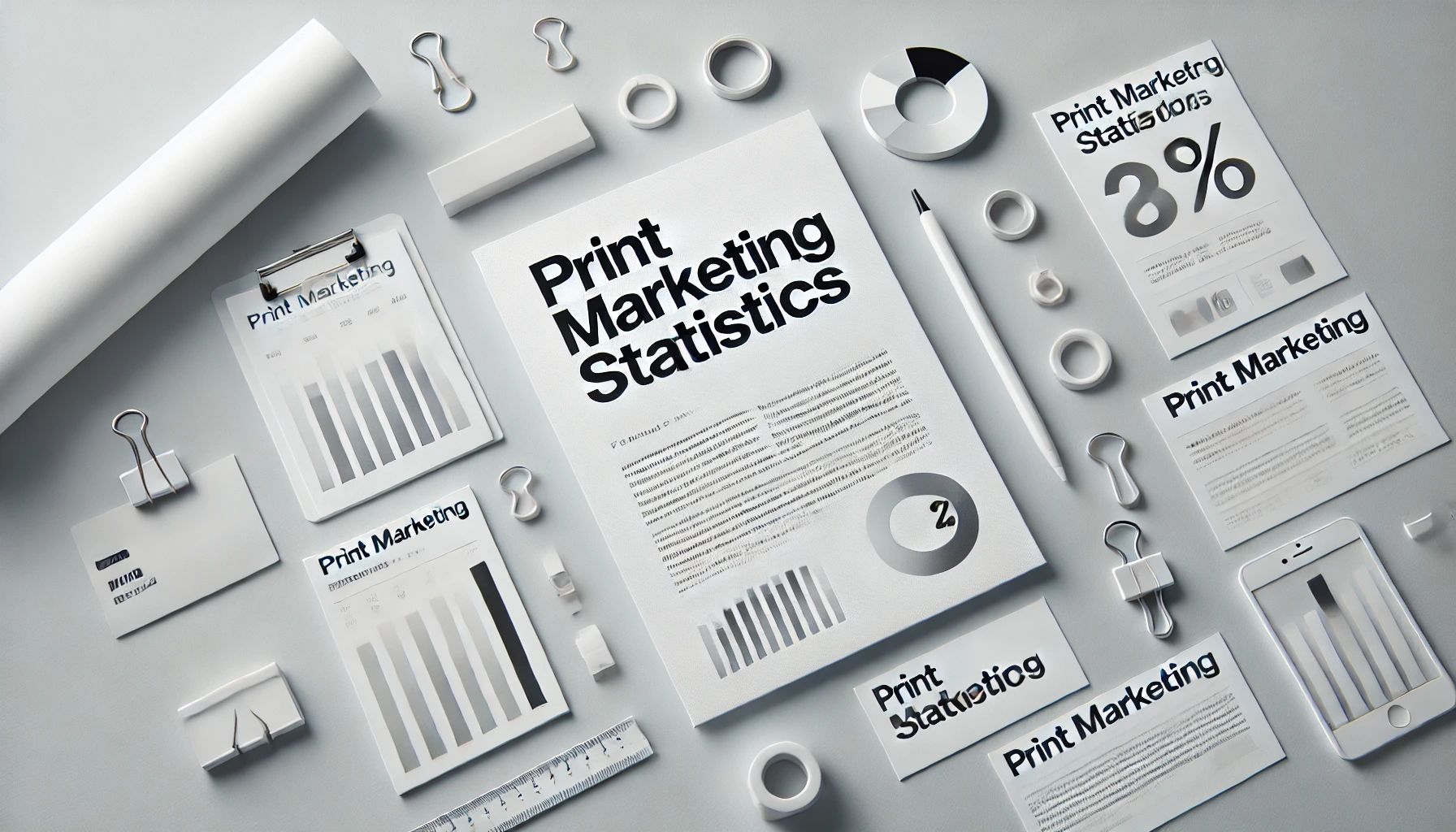
WHAT WE HAVE ON THIS PAGE
- Introduction
- Editor’s Choice
- What is Print Marketing?
- Types Of Powerful Print Advertising
- General Print Marketing Statistics
- Print Marketing Region Statistics
- Consumer Preferences For Reading Print Material
- Perception Of Print Marketing
- Print Marketing Vs. Digital Marketing Statistics
- Conversion Rate Of Print Marketing
- Sales Funnel Statistics
- Advantages And Disadvantages Of Print Marketing Statistics
- Audience Demographics For Print Newspapers
- Future Of Advertising Statistics
- Conclusion
Introduction
Print Marketing Statistics: In today’s digital world, it’s easy to overlook print advertising because online marketing is so popular. However, print ads still hold a lot of value. They give businesses a strong way to connect with their target audience. By using the physical presence of print materials, companies can build stronger relationships with consumers, boosting brand engagement and loyalty.
So, print advertising is still an important part of a complete marketing plan. This article will shed more light on Print Marketing Statistics.
Editor’s Choice
- The global print advertising market is expected to reach $46.23 billion in 2024. Among households earning over $100,000, 70% read newspapers.
- Print advertisements have an average response rate of 9%, while email, paid search, and social media usually get around 1%.
- Additionally, print marketing has a recall rate of 70-80% higher than digital advertising.
- Newspaper advertising is the largest segment of the print market, projected to be $33.35 billion in 2024.
- Also, according to Print Marketing Statistics, 8 out of 10 people trust print ads the most when making purchases.
- Moreover, 90% of print ads are opened, while only 20-30% of emails are opened. In the UK, advertising mail is the third largest media channel, worth about £1.7 billion each year.
- Overall, print advertising is vital for local businesses. It provides targeted reach and helps them connect with the community.
- Print advertising is still an important and effective way to market, even as digital media becomes more popular.
- To create successful print campaigns, it’s essential to target the right audience based on factors like age, behavior, and psychological triggers.
- To measure the return on investment (ROI) for print advertising, you need to focus on key performance indicators (KPIs), use attribution models, and ensure calculations are accurate.
- Print Marketing Statistics stated that understanding how digital media influences print advertising can help you develop integrated marketing strategies that effectively use both channels.
- Additionally, monitoring market trends and changes in consumer behavior can boost the success of print advertising.
What is Print Marketing?
In today’s digital world, it’s easy to overlook print advertising since online marketing is so common. However, print ads still have a lot of value. They provide businesses with a solid way to connect with their target audience. The physical aspect of print materials helps companies strengthen their relationships with consumers, boosting brand engagement and loyalty. So, print advertising is still a key part of a complete marketing strategy.
Types Of Powerful Print Advertising
Print media lets you highlight your brand and products in different ways. Here are four strong types of print advertising:
#1. Newspaper Ads
Newspaper ads are still a valuable way to reach specific audiences. People who read newspapers are often active and interested. These ads are also affordable, reliable, and make a lasting impression.
#2. Magazine Ads
Magazine ads can put your brand in popular publications, either in your local area or across the US. High-quality images can target specific groups and stick with readers long after they finish the magazine. With magazine ads, your creativity is the only limit.
#3. Direct Mail
By doing some research, you can effectively reach specific groups with direct mail. This method allows you to track results in various ways. Direct mail is cost-effective and can be personalized for each person, with many flexible options based on your needs.
#4. Brochures
Even in a technology-driven world, brochures allow you to connect directly with your audience. They help build your authority, credibility, and brand all in one format. Brochures can hold a lot of information and can be handed out to many people at once. Plus, they are one of the most affordable ways to promote your business.
General Print Marketing Statistics
- Print advertising reaches about 120 million US adults every month.
- Print Marketing Statistics stated that almost 45% of consumers prefer reading a magazine over viewing online content.
- Magazine ads provide an average return of $3.94 for every dollar spent.
- 56% of consumers trust print marketing more than any other advertising method.
- The average response rate for direct mail is 4.4%, while email marketing only gets 0.12%.
- Print media has a 90% brand recall rate, the highest among all advertising channels.
- 80% of households are more likely to act after receiving direct mail.
- Global spending on print advertising is projected to reach $70 billion in 2024.
- 79% of households report reading or scanning direct mail ads.
- The average ROI for print advertising is around 130%.
- Newspapers can increase the effectiveness of TV ads by 64%.
- 48% of people keep direct mail for later reference.
- Print Marketing Statistics stated that around 59% of Americans enjoy getting mail from brands about new products.
- 61% of readers trust print ads in newspapers and magazines.
- Direct mail has a response rate of 9% for existing customers and 5% for potential customers.
Print Marketing Region Statistics
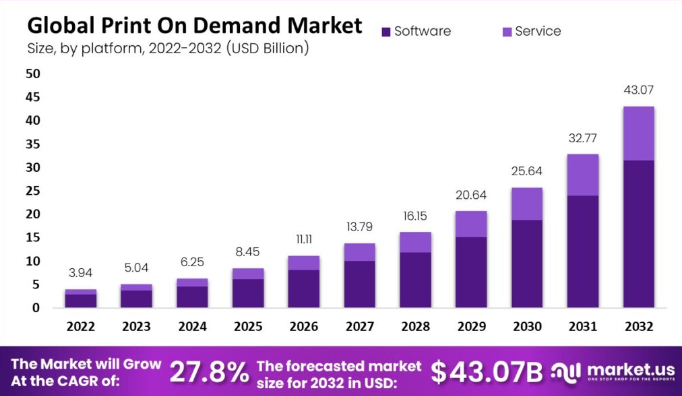
(Source: market.us)
- Global ad spending in the Print Advertising market is expected to reach $34.28 billion in 2024.
- The biggest part of this market is Newspaper Advertising, projected to be $23.57 billion in 2024.
- The United States is the leader in ad spending, estimated at $9.61 billion in 2024, according to Print Marketing Statistics.
- The number of readers in the Print Advertising market is expected to grow to 3.1 billion users by 2029.
- The average spending on ads per reader in the Newspaper Advertising market is projected to be $18.95 in 2024.
- Print advertising is moving towards digital platforms, which is affecting the revenues and strategies of traditional print media.
#1. Print Marketing Statistics- Africa
- Print advertising spending in Africa is expected to reach $0.51 billion in 2024, with a large part of this going to newspaper ads.
- Newspaper advertising is the biggest part of this market, projected to be $0.36 billion in 2024.
- While Africa’s print advertising is growing, the United States is expected to lead the world with $9.61 billion in ad spending that year.
- According to Print Marketing Statistics, the number of readers in Africa’s print advertising market is forecasted to rise to 382 million by 2029, showing a strong audience base.
- On average, newspaper sector spending on ads per reader is estimated to be $2.64 in 2024, indicating a targeted effort to reach audiences through print.
- In Nigeria, print advertising is making a comeback as companies use traditional media to connect with different audiences effectively.
#2. Print Marketing Statistics- United States
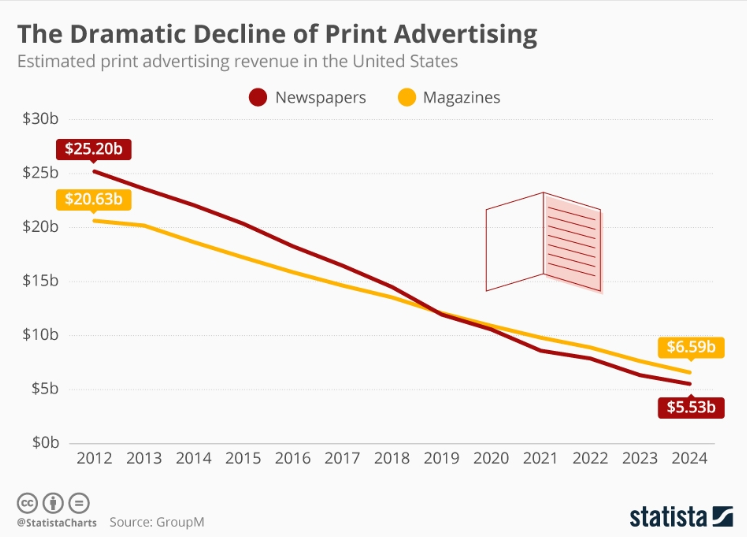 (Source: statista.com)
(Source: statista.com)
- Print advertising spending in the Americas is projected to reach $12.75 billion in 2024.
- Newspaper advertising is the biggest part of this market, and it is expected to total $7.30 billion in 2024.
- The United States is anticipated to lead worldwide in ad spending, hitting $9.61 billion in 2024.
- By 2029, the number of readers in the print advertising market in the Americas is expected to reach 400 million users.
- The average amount spent on ads per reader in the newspaper sector is estimated to be $42.85 in 2024.
- According to Print Marketing Statistics, print advertising in the Americas is seeing a resurgence as companies leverage their unique storytelling opportunities in a mainly digital market.
#3. Print Marketing Statistics- Australia & Oceania
- Ad spending in the print advertising market in Australia and Oceania is expected to reach $0.71 billion in 2024.
- Newspaper advertising is the biggest market segment, with $0.50 billion projected to be spent in this market.
- Globally, the US is anticipated to lead in ad spending, with an impressive $9.61 billion in 2024.
- Print Marketing Statistics stated that the number of readers in the print advertising market in Australia and Oceania is expected to rise to 17.2 million by 2029.
- The average amount spent on ads per reader in the newspaper sector is projected to be $62.20 in 2024.
- Print advertising in Australia is experiencing a comeback as companies are recognizing its physical presence and trustworthiness in a digital-focused world.
#4. Print Marketing Statistics – Caribbean
- Ad spending in the print advertising market in the Caribbean is projected to reach $81.08 million in 2024.
- The biggest part of this market is newspaper advertising, which is expected to be $58.54 million.
- When looking at global trends, the US will lead in ad spending, reaching $9.61 billion in 2024.
- The number of readers in the Caribbean’s print advertising market is expected to grow to 15.2 million by 2029.
- In 2024, the average ad spending per reader in the newspaper market is anticipated to be $9.21. Even with the rise of digital media, print advertising in the Caribbean is making a comeback, appealing to niche markets that prefer real brand experiences.
#5. Print Marketing Statistics- Europe
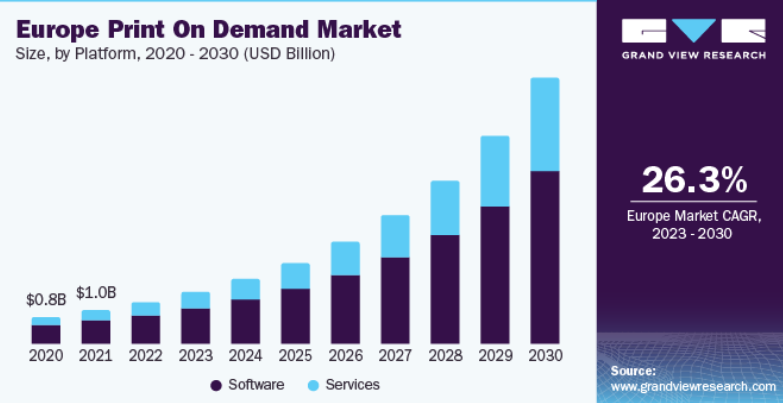 (Source: grandviewresearch.com)
(Source: grandviewresearch.com)
- Ad spending in the print advertising market in Europe is projected to reach $10.59 billion in 2024.
- The biggest part of this market is newspaper advertising, expected to be $7.72 billion.
- On a global scale, the US is set to lead in ad spending, reaching $9.61 billion in 2024.
- By 2029, the number of readers in Europe’s print advertising market is estimated to hit 400 million.
- According to Print Marketing Statistics, the average amount spent on ads per reader in the newspaper market is expected to be $41.41 in 2024.
- In Spain, print advertising is seeing a revival, with traditional formats adjusting to digital trends to effectively connect with a wider audience.
Consumer Preferences For Reading Print Material
- Nearly 71% of consumers prefer reading print marketing materials over online ones.
- Almost 92% of people aged 18 to 23 find it easier to read in print than on a screen.
- According to Print Marketing Statistics, almost 70-80% of consumers enjoy receiving direct mail from businesses they like.
- 70% of Americans believe that snail mail feels more personal than online communication.
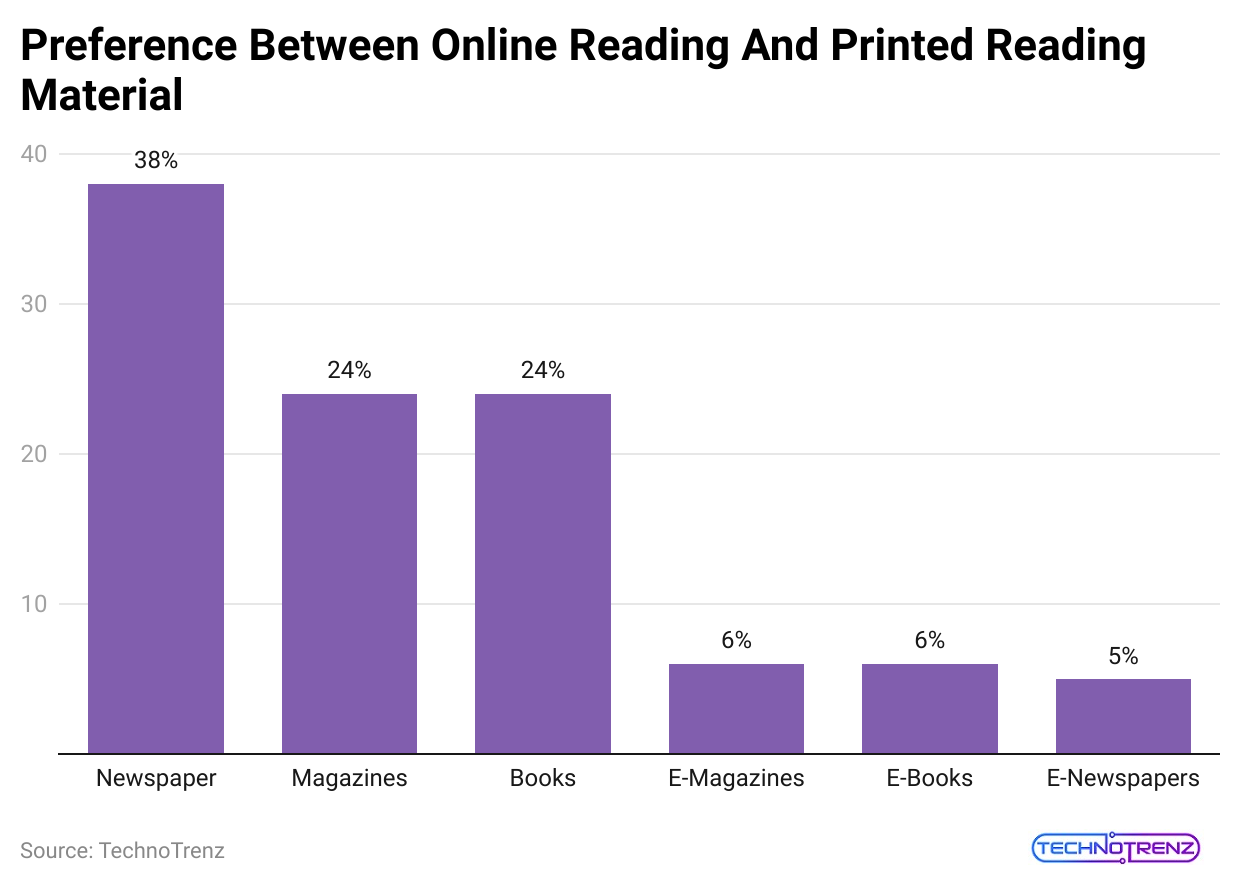 (Reference: researchgate.net)
(Reference: researchgate.net)
- Almost 60% of consumers like reading marketing materials that come in the mail.
- 73% of American consumers prefer direct mail for brand communications.
- Nearly 60% of Americans enjoy checking their mailboxes every day.
- Print Marketing Statistics stated that around 70% of Americans think mail is more personal than digital messages.
- Roughly 84% of millennials take the time to go through their mail.
- 72% of customers prefer connecting with brands through print marketing materials.
- 76% of small businesses think their best marketing strategy includes both print and digital methods.
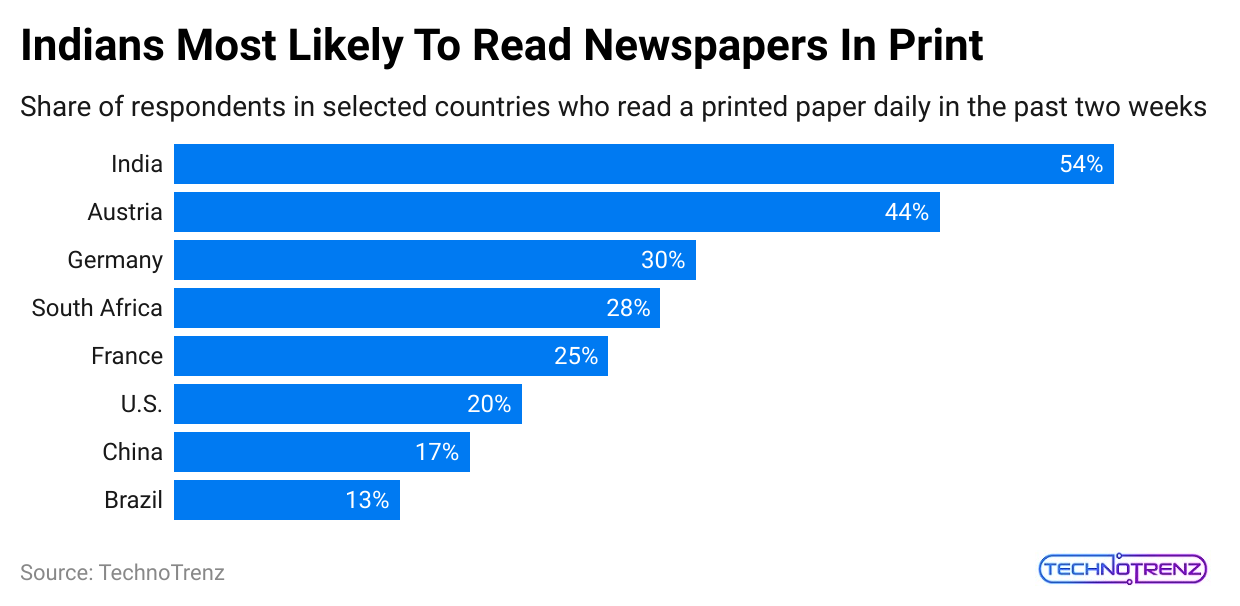 (Reference: statista.com)
(Reference: statista.com)
- Almost 79% of households read or glance at advertising mail sent to their homes.
- 61% of UK consumers value direct mail more than email, which is valued at 51%.
- 82% of Americans prefer reading on paper rather than on screens.
- Around 85% of consumers read or at least skim the marketing materials sent to their homes.
- 67% of consumers feel that print marketing is more personal than digital marketing.
- Nearly 70% of Americans say direct mail is more personal than digital communication.
- 59% of US respondents enjoy receiving postal mail from brands about new products.
- Almost 53% of US consumers prefer getting promotional offers through the mail.
Perception Of Print Marketing
- Most Americans (70%) believe that getting mail feels more personal than using the internet.
- A big 90% of millennials think direct mail advertising is trustworthy, as per Print Marketing Statistics.
- Only 20% of people read all the mail they get, but 70-80% can remember the brands that sent them mail a month later.
- About 85% of consumers say that colorful printed materials make them want to buy more.
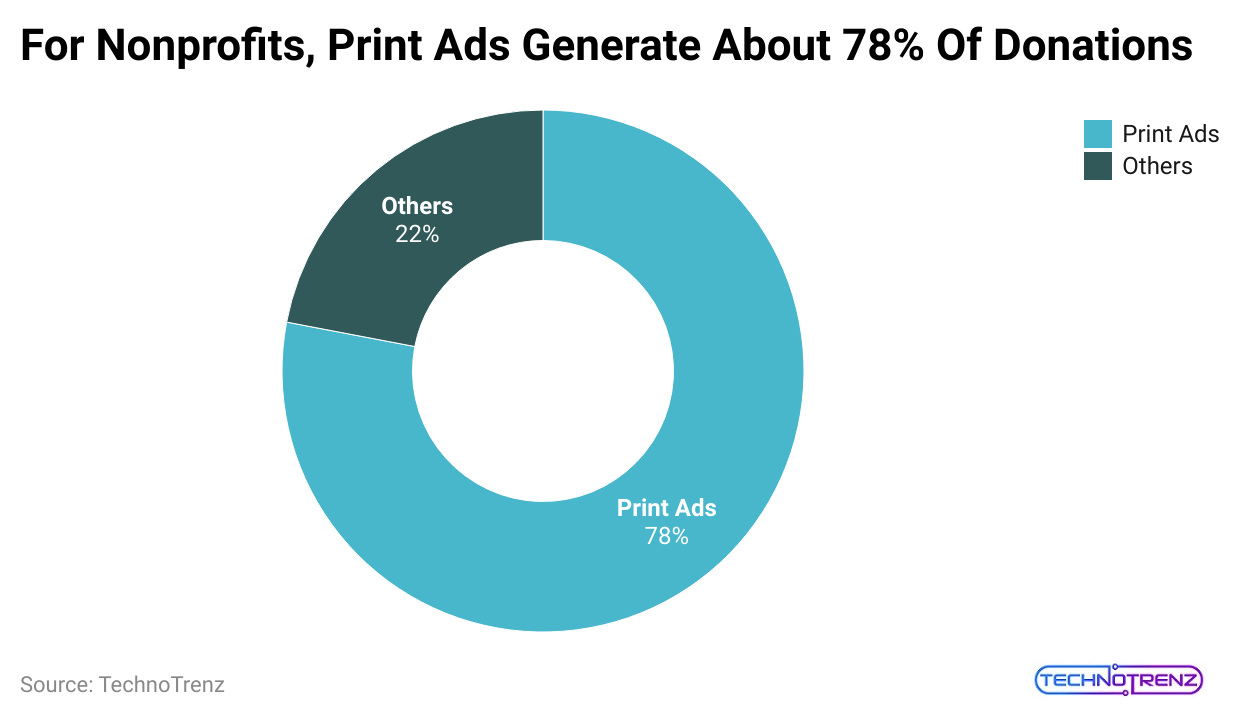 (Reference: persuasion-nation.com)
(Reference: persuasion-nation.com)
- People remember printed ads much better (87%) compared to online ads (35%).
- More than half of consumers (57%) find printed materials the most reliable, and 33% think their direct mail is more interesting than email.
- About 76% of small businesses believe it’s smart to use both print and digital marketing together.
- Many people (75%) like receiving catalogues, and 73% prefer getting mail from brands.
- Many consumers think that print marketing shows a business’s quality, with 51% saying good marketing materials improve people’s perceptions of a business.
- Many people (72%) feel good when they receive direct mail, and 60% think it’s an effective way for brands to communicate.
Print Marketing Vs. Digital Marketing Statistics
- 56% of customers believe print marketing is the most trustworthy form of advertising.
- The response rate for printed direct mail marketing is 37% higher than for email marketing.
- More than 92% of people aged 18 to 23 find it easier to read printed content than digital content.
- Print Marketing Statistics stated that nearly 80% of households read or look at their print advertising mail.
- Roughly 62% of consumers who received direct mail in the last three months made a purchase.
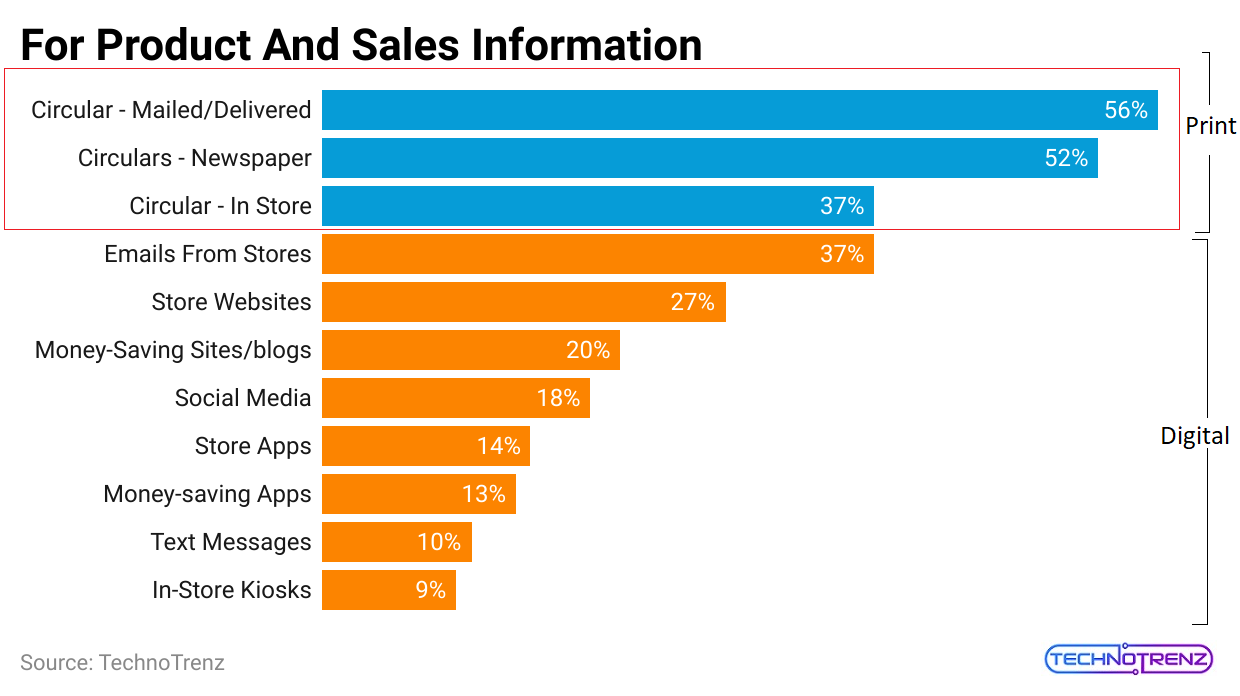
(Reference: business2community.com)
- At least 47% of customers use ad-blockers when browsing online.
- The average return on investment for printed direct mail campaigns is 1,255%.
- 70% of Americans think that mail feels more personal than online communication.
- Brand recall for direct mail ads is 70% higher among people who see both direct mail and digital ads.
- Print Marketing Statistics stated that almost 80-90% of direct mail is opened, while only 20-30% of emails are opened.
- 44% of customers visit a brand’s website after getting direct mail marketing, which is 10% more than those who receive emails.
- Print is eco-friendly and one of the most sustainable industries today. Only 17% of trees cut from forests are used by the paper industry.
- Most paper is recycled at least seven times before adding new wood fibers.
- According to Print Marketing Statistics, 91% of consumers believe that print and paper are sustainable forms of communication when produced, used, and recycled responsibly.
- Spam emails waste around 33 billion kilowatt hours of energy each year, which is similar to the greenhouse gas emissions from 3.1 million cars using 2 billion gallons of gasoline.
- On average, people use 2.4 times more electricity to run a single computer than the energy needed to produce all the paper they use in a year.
- Some argue about the “environmental stress” of sending paper documents, but paper comes from sustainably grown renewable resources.
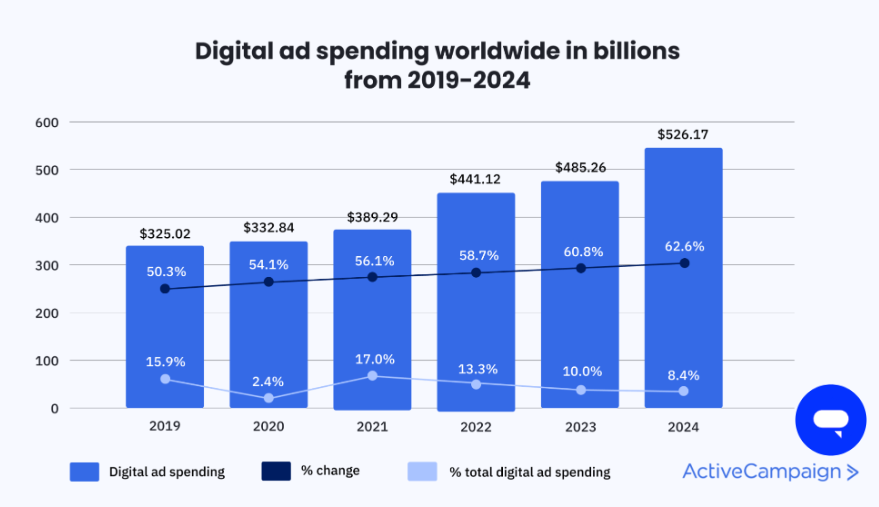 (Source: activecampaign.com)
(Source: activecampaign.com)
- The demand for paper helps promote the ongoing regeneration of forests and contributes to carbon absorption.
- A 2022 study found that 85% of respondents think companies that make negative claims about paper’s environmental impact are just trying to save money.
- About two-thirds of the energy used by pulp and paper mills in North America is self-generated.
- The paper industry uses more renewable energy than any other industrial sector, as per Print Marketing Statistics.
- Overall, the global print and paper industry accounts for only 1% of total global carbon dioxide emissions.
Conversion Rate Of Print Marketing
- Print marketing converts at 2.9%, while digital marketing is at 0.6%.
- 40% of people have tried a new business after getting direct mail. Print ads cost 21% less than digital ads.
- Direct mail gets a 38% response rate for current customers and 24% for potential customers.
- Response rates to existing customers are 3.4% for direct mail compared to 1.6% for digital.
- The average household response rate for direct mail is 4.9%, and it can be up to 5.1% for oversized envelopes.
- Print Marketing Statistics stated that almost 79% of people act on direct mail right away; 98% pick up their mail the same day.
- 63% of recipients purchased within three months of receiving direct mail; 65% have bought something because of it.
- People who receive direct mail buy 28% more items and spend 28% more money compared to those who don’t get it.
- Direct mail campaigns can provide a 13-to-1 return on investment, with an average ROI of 18%.
- Response rates for direct mail have increased by 190% in the past ten years.
- 92% of younger shoppers prefer using direct mail to make buying decisions, and 85% are likely to print coupons they receive in the mail.
- Print Marketing Statistics stated that around 80-90% of direct mail is opened, while only 20-30% of emails are opened.
- In 2023, spending on direct mail advertising in the US was over $10 billion.
- The volume of bulk mail has consistently stayed above 60 billion pieces each year.
Sales Funnel Statistics
#1. Top of Funnel (TOFU)
-
Awareness through Print:
Print advertising is key for building brand awareness. A study by Kantar Milward Brown found that print ads capture 35% more attention than digital ads. Because print is tangible, it effectively grabs the interest of potential customers.
-
Content Engagement:
Content marketing is very important at the top of the funnel. Print materials like brochures and magazines are still widely used, with 79% of consumers saying they find it easier to read content in print. This shows that print is effective for sharing educational information with people who prefer reading in that format.
#2. Middle of Funnel (MOFU)
-
Nurturing Leads:
Nurturing leads is crucial in the middle stage. Personalized direct mail can boost conversion rates by 10-15%. Receiving a physical piece of mail adds a personal touch that digital methods often lack, making print valuable for building relationships.
-
Print in a Multichannel Mix:
The MOFU stage often uses several channels. According to a DemandGen Report, print is the second most popular channel for lead nurturing after email. This highlights the ongoing importance of print in a multichannel marketing strategy.
#3. Bottom of Funnel (BOFU)
-
Closing Sales:
Print catalogues are very effective in driving sales at the bottom of the funnel. A study by the American Catalog Mailers Association found that consumers spend an average of 15 minutes looking at a catalogue, and 62% make a purchase as a result. This demonstrates how powerful print catalogs can be in closing sales.
-
Print’s Impact on Trust:
Trust is vital when making a sale. Research shows that 82% of consumers trust print marketing more than any other advertising method. Print materials help build this trust, which can greatly influence buying decisions.
#4. Cross-Channel Synergy
-
Print as Part of an Integrated Approach:
Print advertising works best when combined with other marketing efforts. Studies indicate that campaigns that include both print and digital elements can achieve a 25% higher response rate. This shows the effectiveness of integrating both channels.
-
Print and Digital Engagement:
The connection between print and digital marketing is very important. About 66% of consumers take action on a print ad after seeing it online. This illustrates how print and digital complement each other, making it essential to have a consistent brand presence across both channels.
Advantages And Disadvantages Of Print Marketing Statistics
Advantages of Print Advertising
Print advertising is one of the oldest forms of advertising and can effectively reach a large audience. It’s useful for promoting both consumer and industrial products. Here’s why print advertising is important:
- Informative: Print ads provide more details about products and services, often more than TV or radio ads do.
- Less Intrusive: Print advertising is less disruptive than things like pop-ups or banner ads. People can choose to read an ad at their convenience.
- Trustworthy: Print ads are usually seen as more reliable than online ads because they come from established publications.
- Targeted: Print ads can be aimed at specific groups, such as readers of certain magazines or newspapers, ensuring the right audience sees them.
- Cost-Effective: Print advertising can be cheaper than TV or radio advertising, as businesses only pay for the ad space rather than airtime.
- Long Shelf Life: Print ads last longer than online ads because people can save magazines and newspapers to read later.
- High Engagement: Since newspapers and magazines require readers to make a conscious choice to read, ads in these formats often engage readers better
- High Recall Value: Print ads tend to be remembered well, as people often see and read them multiple times.
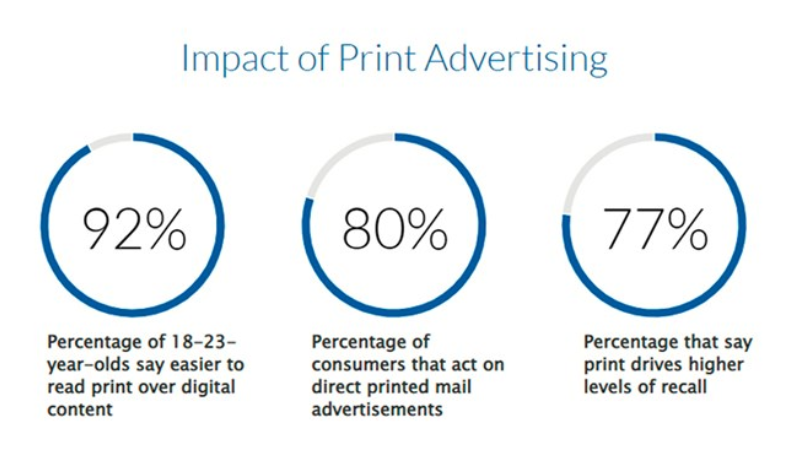 (Source: gardnerweb.com)
(Source: gardnerweb.com)
Disadvantages of Print Advertising
While print advertising has many benefits, there are also some drawbacks to consider:
- Hard to Measure: Tracking the effectiveness of print ads in generating sales or leads can be challenging.
- Expensive: Placing ads in popular magazines or newspapers can be costly.
- Limited Reach: Print ads only reach people who read that specific publication, unlike online ads that anyone with internet access can see.
- Not Interactive: Print ads don’t allow for real-time feedback from potential customers.
- Inflexible: Once a print ad is published, businesses can’t make changes to it.
- Paper Waste: Print advertising creates paper waste, which is harmful to the environment.
- Not Global: Print ads are not suitable for businesses looking to reach an international audience.
Audience Demographics For Print Newspapers
- Only 4% of people who read print newspapers are under 35. Print newspapers are most popular with those aged 55 and older.
- Print media reaches nearly 2.5 billion adults worldwide.
- Print Marketing Statistics stated that print newspapers have a higher readership in rural areas.
- Readers spend an average of 44 minutes with a physical newspaper.
- Print media reaches 55% of wealthy consumers who earn over $100,000 a year.
- Print magazine readership has grown by 16% among adults aged 25-34 since 2019, and there’s been a 6% increase among Millennials in the last year.
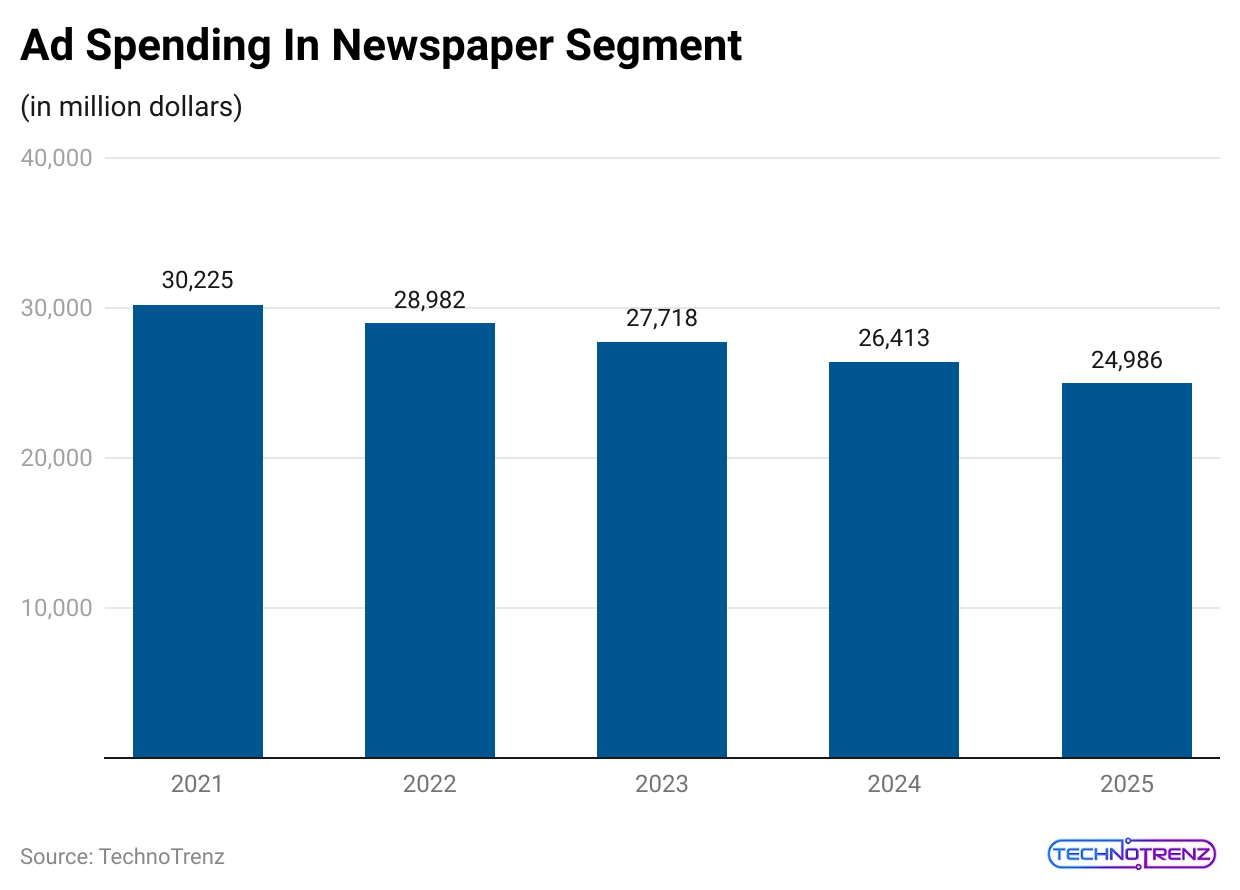 (Reference: gardnerweb.com)
(Reference: gardnerweb.com)
- A significant 86% of newspaper readers prefer the print version over digital formats.
- In the United States, print newspapers reach 70% of adults aged 35-49, and 63% of those aged 65 and older read physical newspapers.
- Print newspapers hold readers’ attention the longest, with an average of 24 minutes spent per issue.
- In the past year, print newspaper readership among adults aged 25-34 has increased by 2%.
Future Of Advertising Statistics
As advertising tools and methods change, it’s important to think about what the future may hold. Will new technologies keep changing marketing and advertising, or could we see a return to more traditional methods? Could sustainability become a key focus in advertising strategies? With these questions in mind, let’s look at some insights into the future of advertising.
- By 2025, global spending on advertising is expected to hit $700 billion.
- Digital advertising will make up 66% of all advertising spending by 2024.
- Artificial intelligence (AI) is predicted to drive 45% of all advertising by 2025.
- Over 80% of internet traffic is expected to be video content by 2022, highlighting the growing importance of video ads.
- Voice-activated smart speakers are estimated to be in 55% of US households by 2022, opening up new chances for voice advertising.
- By 2023, influencer marketing is projected to become a $15 billion industry.
- Programmatic advertising is expected to account for 88% of digital display ad spending in the US by 2021.
- Print Marketing Statistics stated that personalized advertising could bring in an extra $10 billion in revenue by 2023.
- Advertising spending on augmented reality (AR) and virtual reality (VR) is expected to reach $30 billion by 2023.
- Contextual advertising, which uses machine learning, is predicted to hit $125 billion in spending by 2023.
- The rollout of 5G technology is expected to add $12.3 billion to mobile ad revenue by 2024.
- By 2023, around 50% of global internet users are expected to use ad-blocking tools, which will present new challenges for advertisers.
- Thanks to advancements in digital billboards, out-of-home (OOH) advertising is forecasted to reach $38 billion by 2022.
- Global social media users are expected to exceed 4 billion by 2025, making social media ads even more powerful, as per Print Marketing Statistics.
- Spending on connected TV ads is projected to go over $21 billion by the end of 2023, driven by the rise of streaming services.
- Native advertising is expected to make up 74% of all display ad revenue by 2021.
- It is estimated that by 2023, about 30% of internet browsing will happen without a traditional screen, increasing the importance of voice and Internet of Things (IoT) advertising.
- Spending on blockchain technology for digital advertising is expected to reach $1.6 billion by 2024, promoting transparency and trust in the industry.
- Data privacy laws like the General Data Protection Regulation (GDPR) and the California Consumer Privacy Act (CCPA) will greatly impact the future of targeted advertising as they shape the industry.
Conclusion
One of the most impressive facts about print marketing is that it has a 70-80% better recall rate than digital ads. This means consumers are more likely to remember print materials than online advertisements. Also, consumers view print marketing as more trustworthy.
Even though digital marketing has transformed the advertising world, print still plays an important role today. Adding print materials to your marketing plan can help increase brand awareness, generate leads, and boost sales. We have shed enough light on Print Marketing Statistics through this article.
Sources
FAQ.
In addition to the benefits discussed earlier, print advertising has strong response rates and good returns on investment. A study shows that print advertising offers a 112% return on investment, making it a budget-friendly way to reach consumers.
Spending on print media is likely to keep decreasing in the coming years. Forecasts suggest that newspaper ad revenue will fall from $13.6 billion in 2021 to $11.9 billion by 2025, showing a compound annual growth rate (CAGR) of -2.0%.
Here’s the information rewritten in simple English:
While digital platforms provide worldwide access and are cost-effective, print media still has many benefits. Surprisingly, print content connects well with younger people; 92% of those aged 18 to 23 find it easier to read than digital content.
However, print is beginning to lose younger readers. A study shows that 18% of people aged 15-20, 12% of those aged 20-30, and 8% of readers aged 30-40 are less interested in print newspapers and prefer to read online instead. The effect of online media on print readership is very low.

Saisuman is a professional content writer specializing in health, law, and space-related articles. Her experience includes designing featured articles for websites and newsletters, as well as conducting detailed research for medical professionals and researchers. Passionate about languages since childhood, Saisuman can read, write, and speak in five different languages. Her love for languages and reading inspired her to pursue a career in writing. Saisuman holds a Master's in Business Administration with a focus on Human Resources and has worked in a Human Resources firm for a year. She was previously associated with a French international company. In addition to writing, Saisuman enjoys traveling and singing classical songs in her leisure time.



